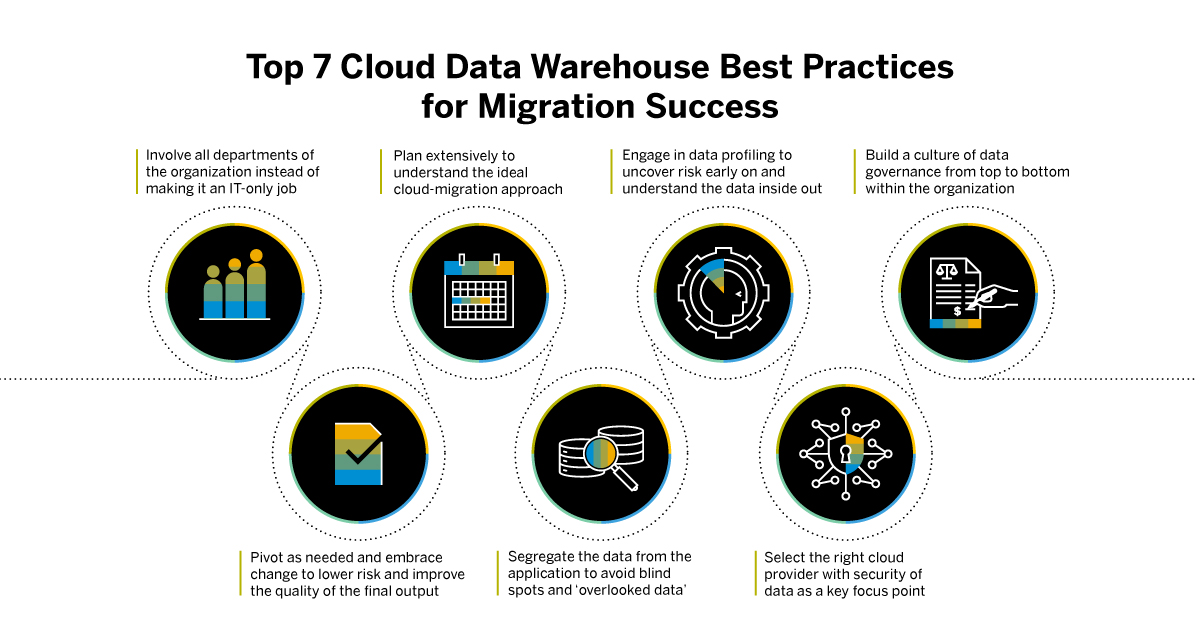Data is the fuel on which modern businesses run. According to Statista, the current data consumption stands at 79 zettabytes a day and is predicted to reach 181 zettabytes a day by 2025. Just for perspective, one zettabyte can store 7.5 trillion MP3 songs as per Seagate.
Given the kind of data-centric world we are heading for, organizations need to take extra care while integrating and migrating data on the cloud.
Cloud-based data migration is simply the process of moving enterprise information and infrastructure from on-premise to cloud computing infrastructure. This involves transferring data, workloads, applications, etc. One area which is steadily gaining traction is cloud data warehouse. Today, 50% of enterprises boast of workloads in the public cloud. Think of a cloud data warehouse as a database that is primarily used to tackle explosive data growth while storing information from a wide variety of sources, including Internet of Things (IoT), CRM, and so on.

Why is Data Migration Necessary?
From new system implementations (think: ERP, CRM, etc.) and mergers & acquisitions to system rationalization and the need for reduced costs, there are multiple reasons why organizations may choose to migrate their data to the cloud. Without real-time, accurate data at hand, enterprises are at a decided disadvantage.
A key enabler of data-driven decision-making, cloud-based data migration can offer a host of business and operational benefits such as:
- Increased scalability, integrity reliability, and security of data with stringent compliance of policies
- Reduced IT costs when compared to cost-intensive on-premise costs such as hardware, software, support, downtime, depreciation cost, etc.
- Environment-friendly, ‘greener’ alternative to on-premise systems and increased energy savings due to reduced need for physical materials for setup
- Increased speed-to-market when delivering projects
- Maximized uptime while backing up data, recovery, and system upgradation, ensuring business continuity
- Easy data availability on-demand leading to increased business agility
- Greater opportunity to leverage newer technologies such as machine learning, artificial intelligence, etc. and drive innovation
- Increased productivity due to consolidated data centers and the ability to outsource data management capabilities to a third party, allowing enterprise resources to focus on more high-value tasks
- Accelerated digital transformation and organizational growth as CTOs and leaders can opt to digitize core functionalities easily and seamlessly
- Better product delivery that is aligned with the user’s needs as the team focuses more on the user experience instead of constantly struggling with the data
Top 7 Cloud Data Warehouse Best Practices for Migration Success
1. Involve all departments of the organization instead of making it an IT-only job.
Most enterprises view data migration as the sole responsibility of the IT team–a big mistake. To drive migration success, consider the ‘human element.’ In other words, enterprises need to engage in behavioral management and involve all stakeholders across the board at all stages of data migration. This can be done by driving stakeholder participation and ensuring that the key resources are always available during the migration process. Doing so can throw light on hidden issues early on in the project and take the guesswork out of the equation.
The reason:
In reality, data migration failure is not always hardware- or software-dependent; it is behaviorally driven and a collective effort. Enterprises need to relook at their data migration process via a collaborative lens and ensure that every team is on board.
2. Plan extensively to understand the ideal cloud-migration approach.
Instead of viewing the data migration process as an isolated event that involves moving data from point A to point B, view it as a continuum of moving parts working together to enhance organizational performance and competitive edge. Simply put, there needs to be a greater effort in the ‘planning’ stage to ensure that enterprises:
- Benefit from an end-to-end, repeatable process flow
- Understand the best-associated methodology and approach for data migration
- Engage in a cost-benefit analysis to integrate a pay-as-you-go model instead of paying for additional infrastructural costs
The reason:
There are numerous types of cloud migration strategies that enterprises can adopt depending on their size of business and data complexity. Some of the most common strategies include re-hosting, re-platforming, re-architecting, re-purchasing, and retiring. Without proper planning, organizations will not be able to understand their existing IT environment and the kind of cloud vendor to choose to advance their data migration goals. Additionally, it can lead to prolonged downtime due to a chaotic data migration process, eventually costing organizations $5,600 per minute, according to estimates by Gartner.
3. Engage in data profiling
Data profiling is essential for two reasons. One, it helps uncover risk early on. Two, it empowers enterprises to understand the data inside out fully. Moreover, using the profiling results gathered, stakeholders can be engaged across diverse aspects such as:
- Driving root cause analysis to identify business process flaws within the data
- Having empirical discussions about the data state
- Driving discussions on prioritizing requirements that are essential versus ‘nice to have’
- Identifying and analyzing inconsistencies in the data between the environment’s documented state and the true state
- Gauging the level of effort required to ensure that the data is fit for the prioritized purposes
The reason:
Accurate estimates about the time and effort required cannot occur without data profiling at the beginning of the migration process. In other words, if you want to successfully migrate data without letting guesswork get in the way, data profiling is necessary.
4. Build a culture of data governance
Data migration is as much about the people and processes engaged in the process as it is about technology. To cater to the ‘human’ factor of the data migration aspect, ask the following questions before deep-diving into the data migration process:
- Which resources need to be involved?
- What do ‘good data’ and ‘data duplicate’ constitute?
- What to do when remediating a data quality exception?
- What does the escalation process look like if a decision cannot be made?
- How to deal with the initial spike of remediation needs versus the steady state?
- How to ensure data quality after going live?
The reason:
To effectively manage data governance, leaders need to ask these questions and devise a strategic plan–one that aims at establishing a culture of data governance from top to bottom within the organization, and caters to the needs of the end-user as well as the internal stakeholders.
5. Pivot as needed and embrace change
As organizations get more visibility into the data, iterations may be required at every step of the data migration flow. This lowers risk and improves the quality of the final output. It also doubles up as an opportunity to add cleansing rules with every iteration. As a thumb rule, organizations should iterate as often as needed. The end goal is to embrace change as readily as possible.
The reason:
Leaders need to focus on strategizing ways to help drive ‘change management.’ In simpler words, this translates to enabling people to readily embrace the changes in adaptability by:
- Training employees on the new system
- Designing, implementing, and monitoring a plan to support–and back up–the change keeping in mind the end-user and the team’s needs
6. Segregate the data from the application
Most organizations make the mistake of not separating the distinct needs of the data and the application. While these two may be connected, they have individualized requirements. Another key area of concern is rushed application and data assessment, where enterprises do not completely assess the workloads. This leads to a skewed understanding of which migration approach to undertake for the specific data and applications.
The reason:
Without segregating the data from the application, there will be blind spots and ‘overlooked data’ within the architecture. Plus, data segregation also helps to understand the remediation aspects to undertake for the project. Finally, it empowers enterprises to understand the specific migration requirements and eliminate the chances of scope creep.
7. Select the right cloud provider with security of data as a key focus point
When it comes to finding the best fit for migration support, tools, safety, or approaches, selecting the right cloud provider is paramount. Companies should investigate whether the cloud providers have the necessary data migration tools to move data by considering factors of vendor lock-in and portability.
Think of it as ‘expectation management’ between the two parties involved by having proper written and authorized documents–or an SLA (Service Level Agreement–as it is commonly known. Considering that most organizations would want to outsource their infrastructure services to the cloud providers so that they can focus on the core business, selecting the right cloud service partner can allow for better strategic business goals alignment as well as profitable outcomes.
The reason:
Most CTOs opt for a migration partner based on low pricing or familiarity instead of factoring in ‘experience.’ This can lead to mistakes and rework, causing your cloud migration costs to go off the rails. In addition, there are increasing concerns with respect to security protocols between the client and cloud providers, leading to the inevitable ‘trust deficit.’ Finally, if the vendor does not plan and execute the security protocols properly, data breaches will become an everyday issue, costing the enterprise millions.

The Bottom Line
Data migration will continue to gain momentum with the global public cloud spending poised to exceed $480 million by 2022, according to Gartner. Clearly, not building a roadmap for the data migration journey is already ensuring that the organization is set up for failure. After all, moving data from legacy to cloud is not a simplistic, linear approach.
To help drive better decisions and deliver a safe, cost-effective, and results-oriented data migration process, sticking to the best practices outlined above can make the process simpler, more streamlined, and scalable while being cost-effective.



